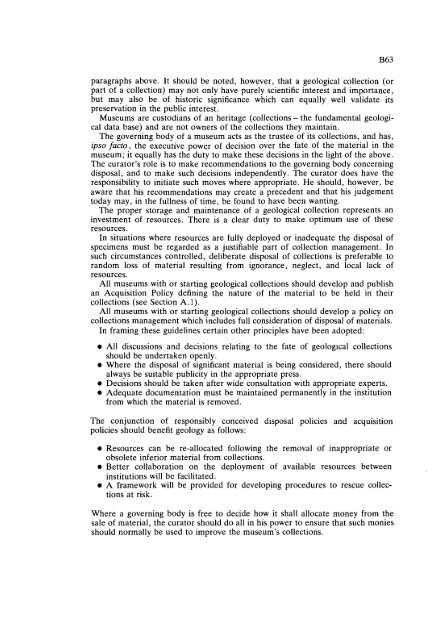GUIDELINES FOR THE CURATION OF GEOLOGICAL MATERIALS
GUIDELINES FOR THE CURATION OF GEOLOGICAL MATERIALS
GUIDELINES FOR THE CURATION OF GEOLOGICAL MATERIALS
You also want an ePaper? Increase the reach of your titles
YUMPU automatically turns print PDFs into web optimized ePapers that Google loves.
paragraphs above. It should be noted, however, that a geological collection (or<br />
part of a collection) may not only have purely scientific interest and importance,<br />
but may also be of historic significance which can equally well validate its<br />
preservation in the public interest.<br />
Museums are custodians of an heritage (collections - the fundamental geological<br />
data base) and are not owners of the collections they maintain.<br />
The governing body of a museum acts as the trustee of its collections, and has,<br />
ipso facto, the executive power of decision over the fate of the material in the<br />
museum; it equally has the duty to make these decisions in the light of the above.<br />
The curator's role is to make recommendations to the governing body concerning<br />
disposal, and to make such decisions independently. The curator does have the<br />
responsibility to initiate such moves where appropriate. He should, however, be<br />
aware that his recommendations may create a precedent and that his judgement<br />
today may, in the fullness of time, be found to have been wanting.<br />
The proper storage and maintenance of a geological collection represents an<br />
investment of resources. There is a clear duty to make optimum use of these<br />
resources.<br />
In situations where resources are fully deployed or inadequate the disposal of<br />
specimens must be regarded as a justifiable part of collection management. In<br />
such circumstances controlled, deliberate disposal of collections is preferable to<br />
random loss of material resulting from ignorance, neglect, and local lack of<br />
resources.<br />
All museums with or starting geological collections should develop and publish<br />
an Acquisition Policy defining the nature of the material to be held in their<br />
collections (see Section A.1).<br />
All museums with or starting geological collections should develop a policy on<br />
collections management which includes full consideration of disposal of materials.<br />
In framing these guidelines certain other principles have been adopted:<br />
All discussions and decisions relating to the fate of geological collections<br />
should be undertaken openly.<br />
Where the disposal of significant material is being considered, there should<br />
always be suitable publicity in the appropriate press.<br />
Decisions should be taken after wide consultation with appropriate experts.<br />
Adequate documentation must be maintained permanently in the institution<br />
from which the material is removed.<br />
The conjunction of responsibly conceived disposal policies and acquisition<br />
policies should benefit geology as follows:<br />
Resources can be re-allocated following the removal of inappropriate or<br />
obsolete inferior material from collections.<br />
Better collaboration on the deployment of available resources between<br />
institutions will be facilitated.<br />
A framework will be provided for developing procedures to rescue collections<br />
at risk.<br />
Where a governing body is free to decide how it shall allocate money from the<br />
sale of material, the curator should do all in his power to ensure that such monies<br />
should normally be used to improve the museum's collections.

















